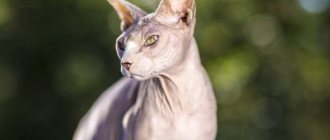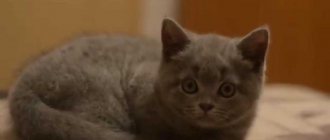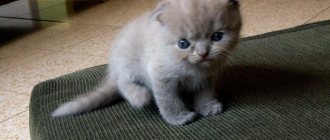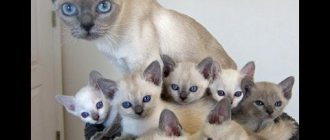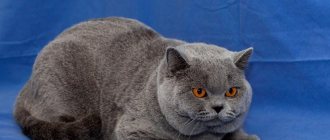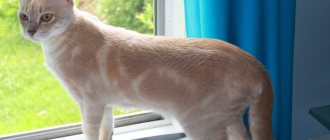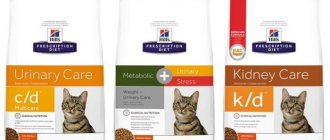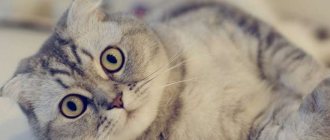The British are the aristocrats of the cat world. Looking at them brings incredible aesthetic pleasure. If you desperately want a cat that will add comfort and warmth to your home, but are afraid that you won't have enough time for a pet, the British is the right breed.
British cream cat
Beautiful, or better yet, luxurious, independent and charming animals with a calm disposition. What's the catch? It would be a lie to say that there is none. Before purchasing a plush kitten, it is better to learn in more detail some points about the character of the British. Then, if you decide that such a pet is ideal for your temperament, do some research on hereditary diseases in the British.
The British cat breed is exactly the option when the miser pays twice. Advertising sites are full of inexpensive kittens. On the other hand, the price for a kitten from a nursery can reach 15-50 thousand rubles. Where does such a range of prices come from and is there any point in overpaying? You need to figure this out on your own. After all, breeders of any price category have their own selfish interest - to sell kittens, so all their words and statements must be considered from a critical point of view.
Author of the article: Olga Shiltsova, practicing veterinarian, author of the books “Dachshund of Fate” and “Tails of Fortune”
The cutest cats in the world: the appearance of the British
The British cat is the embodiment of “blue blood”. When a person says “I have a purebred cat,” then most often we imagine an imposing British cat. Their appearance has become the ideal of feline beauty for millions of people: the breed is second in popularity only to the Scottish Fold.
Britons are quite large animals. Males weigh 5-8 kg, females about 4 kg. Pedigree characteristics are most clearly manifested in cats. Their silhouette looks squat (short, strong legs), and all shapes are soft and rounded. The tail is thick and short, with a rounded tip. Cats look very harmonious and proportional.
British silver chinchilla cat
A separate song can be dedicated to the head of British cats. Those cheeks! The head looks round no matter which way you look at it. A wide skull, a pronounced massive chin - the British cat personifies strength and solidity. Round, dense cheeks give the impression that the cat is constantly smiling into its whiskers.
The British have a recognizable head shape
The large round eyes of the British have a breed feature: a bright copper color. Exceptions are allowed for certain colors: silver cats will have green eyes, while pure white cats may have blue, yellow or different colored eyes. Cats of the so-called “Siamese color” (colorpoint) always have blue eyes.
British blue cat: bright copper eyes are magnificent
British cats of a certain color have an unusual phenomenon - eyes of different colors.
British bicolor cat with heterochromia
You can read about heterochromia and see more photos of different-eyed cats HERE (the link will open in a new tab).
The fur coat of British cats is the pride of the breed, their signature feature. The short, dense coat looks plush and soft and is gentle to the touch. The secret is that the guard hair and undercoat of the British are the same length, no more than 2.4 cm, and the coat is very thick.
British color point cat
A British cat can have almost any color; to list all the color combinations would require a separate rather large article. In Russia, the most famous are the blue color, and after the advertisement of the famous cat food - the silver tabby, which is called the “Whiskas” color.
Next to a blue cat is a teenager of Whiskas color
What breeds were involved in the creation of British cats
British cats are considered by some to be an aboriginal breed - one that formed on its own, without active human intervention. In many ways this is true. Cats were brought to the islands of Great Britain by Roman legionnaires many years ago. On an island isolated from the mainland, the cat population developed “in itself”, without the infusion of fresh blood, but with strict natural selection. After all, cats did not live in houses, but on farms, fields, grain barns and factories. As a result, large cats with heavy bones and dense, thick short hair roamed the streets of England.
British cream color
At the end of the 19th century, targeted selection of British cats began, and for some time the breed was called the “British Blue”. At first, blue was the only acceptable color, then it was the most common, but now the variety of colors of the British is amazing.
"Classic" blue color of British cats
The breed's numbers declined twice in the 20th century - after the First and Second World Wars. In order not to lose the British, they were crossed with ordinary outbred shorthair cats. And in order to return the desired rounded appearance of the head, they began to involve in the breeding of Persians.
It was not possible to obtain stable offspring, and the British began to be mated with Russian blue cats, as well as Chartreux cats. Then they returned to the infusion of Persian blood, weeding out kittens that were too snub-nosed or had long hair. It was the Persians who “gave” British cats more than 200 variations of coat color.
In 1982, the two breeds were finally separated: British and European Shorthair. At the same time, the British breed standard was written.
Choice of kitten and price
If you are thinking about buying a kitten, you should immediately decide which category of buyers you belong to: Do you need a truly purebred British cat and are you willing to pay for it and subsequently cover the cost of maintenance, or do you need a cat that looks very similar to a British cat.
The British Shorthair cat is a very common breed. There are many nurseries, but there are even more unfortunate breeders who should have castrated their pet class animals, but decided not to do this, but to earn a little money. Because of this, the number of “thoroughbred British” at a reasonable price is growing at an incredible pace.
The only sign that the kitten is a British Shorthair is the metric or pedigree! No “similar”, “very similar” or “purebred parents, but without documents” are breed characteristics.
Take the kitten from home, then you can not only observe it in its home environment, but also see its parents and living conditions. The baby should be healthy, active, with an excellent appetite. A good breeder will never give away a kitten younger than 3 months until the full course of vaccination has been completed. Babies at this age should already be accustomed to the scratching post, tray and people. The Kitten must have documents confirming its origin, this can be a metric or a ready-made pedigree.
The cost of kittens varies widely. The cheapest: pet-class babies of common colors.
The most expensive: animals for exhibitions or breeding with a rare appearance.
Average prices for British Shorthair cats:
- Pet class kittens cost $250-500.
- For a kitten for breeding you will have to pay 400-800 dollars. Moreover, cats are usually more expensive than cats;
- Show class animals cost from $800.
You can also sometimes find bred adult British dogs for sale for up to $150.
Plush on the outside, tough on the inside. The character of the British.
When you look at the cheeky little plush, round on all sides, you have an uncontrollable desire to squeeze the Briton endlessly. And here you will be greatly disappointed - British cats do not tolerate familiarity! Although kittens may willingly play with their owner and cuddle, adult cats behave more than independently.
Silver tabby kitten plays with a teaser fishing rod
They rarely or never come to sit on your hands. If you start stroking a pet that is sleeping or minding its own business, the cat will most likely leave, or prove that sharp claws are hidden in its soft paws. All that remains is to humble yourself and caress the Briton only with your eyes.
The owners of these luxurious cats admit that sometimes they do not feel like their owners. Sometimes it seems that everything is the other way around: Mister Cat lives in the apartment, the rest are service staff.
“I am the queen, and you are the two-legged food giver.”
This does not mean that British cats do not need love and care. They seek attention from people just like other cat breeds - but only on their own terms. A curious animal may simply follow you from room to room, carefully observing what its person is doing.
The manners of the British are inherently respectable; they rarely rush around the apartment or jump on cupboards. If you get used to the scratching post in a timely manner, you won’t have to worry about the furniture. They are not mischievous or annoying.
British chocolate cat
British cats only vocalize on special occasions. If we are not talking about sexual heat or severe stress (a trip in the car, a visit to the veterinarian), some owners do not hear their pet meowing for months. Meowing while begging for food is beneath the dignity of these aristocrats. Rather, you will be haunted by the gaze of large round eyes, reproachful.
In general, the breed is considered quite phlegmatic: the British have a calm and even character. To prevent your pet from completely turning into a sofa cushion, excess weight should not be allowed to appear.
Too thick
British cats are not a suitable breed for families with children. Rarely does a Briton favor children: they are too noisy, too clingy and lacking in delicacy. No, a cat is unlikely to scratch a child, even if he pulls his tail. But the life of a Briton will turn into constant stress and the search for a reliable refuge, where no one will disturb him to take a peaceful nap. These cats are not ready to play for too long, and even more so, they do not like to be persistently petted. Explaining to a child that this teddy bear is inviolable will not be easy.
Get your little hands off me, little man!
British newborns, what they look like, photos
Outdoor cats choose dark, warm places to give birth, usually basements and attics. At home, you need to provide a “birther” for the British woman. It can be made from a large box, 60x60 cm in size, 40 - 50 cm high. Store banana boxes and exhibition tents are suitable. Lay out a diaper for animals and a heating pad.
Depending on the number of kittens in the cat’s womb, a newborn kitten can have a body length of 8 - 12 cm, the weight of kittens is from 70 - 120 g, there are small ones of 50 - 60 g, this happens when there is a multiple pregnancy. Weight table here.
The British are born blind, deaf, with large claws, without undercoat, the fur is not able to warm the baby, so you need to monitor the temperature of the “birthing place” ≈ 38 - 39 C⁰. At the age when kittens sleep 95% of the time, their innate sense of smell and touch allows them to find the cat's nursing nipple. The British mother licks the kittens; without her, they are unable to defecate. In the period from birth to 2 - 3 weeks, you should monitor the daily weight gain of babies by 10 - 20 grams, they should be weighed in the morning at the same time. If someone does not finish eating, then put it on the nipple more often.
Photo – British kittens 3 days old
Stages of development of a newborn British baby by day:
- Days 1 – 3 – baby sleeps, eats; how to determine the sex of newborn kittens is described in detail here
- 3 – 6 days – the umbilical cord heals, becomes black, dries out, and falls off;
6 days per photo
the picture shows that some already have an umbilical cord missing
- 4 – 7 days – hearing is formed, there is a reaction to loud sounds. The British are all straight-eared!
Plush kittens at 1 week
During this period, babies begin to crawl more actively, and many begin to open their eyes. Children's undercoat is formed and they react more actively to sounds.
British 7 days | 1 Week
It's time to increase the area for cats and choose a name.
British kittens in a playpen
Video of the British in 10 days below.
Little kitties 2 weeks old
British Shorthairs grow quickly, their weight has tripled since birth. They began to sleep less, eat less often, but the portions became larger. They begin to walk unsteadily, with long claws allowing them to maintain balance. By the end of the second week, the eyes open, they will immediately be a little cloudy. The first eye color is blue. They are seen a couple of days after opening on days 14–17. They hear the cat better and respond to its purring.
2 weeks
14 days
British 3 weeks
Kitties see and hear everything, sit and walk confidently, and try to jump. Baby teeth are visible. They are very curious and try to get out of their beds, so it is worth using fences and playpens. The area for children to play should be increased. Provide a scratching post, soft toys, a tray with filler and water.
The cubs actively play with each other, bite and hiss, and practice hunting skills.
2.5 weeks
3 weeks
Is it difficult to keep a British cat?
You have to pay for everything - and in the case of the British, you have to pay for the cat’s incredibly beautiful fur coat with fur all over the apartment. In addition to seasonal molting, the undercoat is renewed all year round. Therefore, it is recommended to brush British cats regularly: in addition to regular brushes, you will need a furminator.
The pet is given products that facilitate the passage of fur through the digestive tract, otherwise the cat will suffer from trichobezoars (periodic vomiting, gastritis, constipation). This could be malt paste or special food. Brushing largely eliminates this problem, but grooming must be regular. Many owners also prefer to trim their pet's claws 2-3 times a month.
There are no other special features of caring for British cats - and this is one of the secrets of their worldwide popularity. The British easily learn to go to the litter box and use a scratching post, and learn other rules of behavior established in the house.
Among the disadvantages of the breed: they have difficulty getting along with other animals, especially if they begin to bother them. The British will not tolerate such arrogance. These cats are more likely to agree to be the only ones in the house, and are not at all bored when alone.
White Briton: let me sleep peacefully!
Application
Black British cat, red, white or any other color - this bundle of warmth and happiness will become a favorite in your home.
This breed of cat, like the pixie-bob, is perfect for keeping in the countryside and cottages, as well as for city life in an apartment.
Cats can be used as show animals and for commercial purposes (breeding, sale of kittens).
British cats have a great sense of style
Hereditary diseases: what you need to know about British health
The incredible popularity of the breed led to sad consequences. People simply bred their British cats with anyone, knowing that there would still be a queue for the kittens. It’s easy to sell such “British” dogs without documents, but 5 times cheaper than from the breeder. And buyers are happy - after all, they don’t want a cat for exhibition, but for the soul.
British kitten, silver tabby color
As a result, the British were bred with the Scots, animals with obvious defects such as too flat a nose were allowed to breed, and producers who brought kittens with congenital diseases were not culled. All this has led to the fact that the once healthy cat breed is considered one of the most problematic among veterinarians. “What did you want, you have a Briton,” - this phrase can easily be heard in a veterinary clinic. Before you run for a kitten “from an advertisement” or look for a mate for your “sort of British” cat, you need to study information about these diseases:
- Blood type incompatibility.
Like humans, cats have different blood types: A, B and AB (the latter is very rare). The blood type greatly depends on the breed of the pet. For example, all Siamese have blood type A. British cats have a problem: part of the population has blood type A, but 30-60% have blood type B. If animals with different blood types are bred, serious problems can arise in the kittens.
British cats are caring mothers
If the blood type of the mother and fetus do not match, pregnancy and childbirth proceed absolutely normally. But then the kittens suddenly die without showing any symptoms of illness. Sometimes they can survive for several days, their urine will be brown in color. The reason is that through their mother's milk they receive antibodies that destroy their blood cells. Anemia and kidney failure lead to the death of kittens.
Preventing the problem is simple: if a cat has blood type A, it is bred with cats that have blood type A. If a cat has blood type B, it is necessary to select a partner with blood type B.
Do careless breeders think about this? Hardly. In professional nurseries? Yes.
- Polycystic kidney disease.
Persian cats, who actively participated in the development of the British breed, gave it a terrible hereditary disease - polycystic kidney disease. If a cat was given a defective gene at birth, then regardless of the living conditions, it develops kidney failure. Such animals live from 3 to 10 years and require constant treatment.
There are genetic tests that must be carried out for breeding animals. Cysts can be detected on ultrasound from 3 months of age and later. The older the cat, the more obvious the changes in the kidneys become.
British tortoiseshell
- Heart disease.
The real killer of British and Scottish cats is hypertrophic cardiomyopathy (HCM). With a hereditary defect, the wall of the heart thickens and the chamber becomes smaller, and the heart cannot pump blood properly. With HCM, a seemingly healthy cat can die suddenly at a young age.
All Britons need to have a heart ultrasound scan called echocardiography. Usually, owners find out about this before castration of the pet or other surgical operation: anesthesia provokes the manifestation of the disease. But British cats involved in breeding need to be examined before the first mating, even if there are no signs of disease. Usually an ECHO is done upon reaching 1 year of age.
Young British silver tabby (Whiskas)
- Atresia of the lacrimal punctum.
Normally, the tear that washes the eye goes into the nasal cavity through a special channel. In the absence of the lacrimal punctum or its occlusion, constant lacrimation is observed. Animals with this problem can be easily identified by the brown trails that extend from their eyes. Lacrimal punctal atresia is a problem that runs in families, so Britons with this condition should never be bred. Treatment is only surgical.
This problem is more common in British cats of the “extreme type”, with an excessively shortened muzzle, like the Persian.
Classic British: the muzzle should not be flat and the nose should not be depressed
If you buy a British dog that is free from all genetic defects, then you can hope that the pet will delight you with excellent health for many years. Cats of this breed are somewhat prone to obesity due to their calm temperament, but this problem can be easily solved with proper feeding.
Feeding
British cats are not whimsical and rarely go overboard with their food, but they still need a balanced diet and clean water.
Take the time to create a special diet for them, because the British have a good appetite and are prone to obesity.
If the food consists of natural products, then it is better to feed:
- beef (lean);
- chicken;
- fish (boiled);
- egg yolk;
- dairy products.
Vegetable puree from zucchini or carrots will also work.
From dry food, it is better to choose Super Premium food, as well as canned cat food, according to their age.
For example, many pet stores offer Royal Canin food exclusively for the British shorthair or longhair breed.
Reviews from British cat owners
“My Churchill behaves like a true aristocrat; one can envy his restraint. He tolerates nail trimming and brushing, never meows over trifles, but purrs and purrs so that you can hear him from everywhere. We joke that this is the ringtone of our house. Although he is an independent man, he always meets and accompanies him to work. When he wants to be pampered, he has to put everything aside and scratch and stroke. Smart as a person. Always looks straight into the eyes. Adored beyond belief!”
“Sir Tyson is the most beloved member of the family. But he can’t be picked up, he can’t lie on his lap, he can’t sleep on the floor - only on his personal chair. He eats the same brand of food and has never stolen from the table. Talking to us. When he is being petted before bed, we pay attention to him while he is in the mood.”
“When you return from work, the cat appears slowly, almost piecemeal, like the Cheshire cat. He sits down and looks - they say, where they were hanging around and how long to stay with us. Slowly washes off. He may freeze with his paw raised - he is thinking about something. He never asks for food. At most he can sit by the bowl, doesn’t look at you, just a living reproach. If you catch him eating something from the table, he doesn’t run away, doesn’t scream - sorry, it’s not me, the devil has confused him. Oh no! He simply looks reproachfully at where the equipment is and why he is forced to eat in such poor conditions. Mars sheds constantly, tolerates a dacha, but is not enthusiastic about fresh air.”
“They allow themselves to be loved - these words say it all. And you will be happy that you were allowed to live with these celestials."
“Zero attention to pussy-kiss-kiss, he won’t even turn an ear. It’s worth calling by name - immediately interrogative Mr-r-r-r, no matter where she is at that moment.”
“I had a British guy. I still remember with irritation how contempt for bipeds was imbued with his every glance. The self-esteem is simply exorbitant. I described the entire apartment, the stench could not be removed by any means.”
